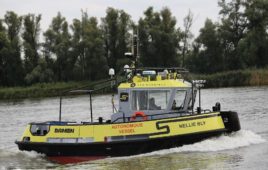A Chinese ship equipped with advanced sonar equipment will soon join the search for the Malaysian airliner believed to have crashed in the southern Indian Ocean almost two years ago, an official said on Friday.
The Dong Hai Jiu 101 will leave Singapore on Sunday to join the hunt for Malaysia Airlines Flight 370 over a 120,000-square- kilometer (46,000-square-mile) expanse of deep seabed by late February, Australian Deputy Prime Minister Warren Truss said.
The ship brings the state-of-the-art Synthetic Aperture Sonar (SAS), which some experts say is more accurate than standard 75 kHz side-scan sonar devises that have been used to scan most of the area searched so far.
With standard acoustic sonar, the image becomes less clear the farther a seabed object is from the equipment. But with SAS, the image remains sharp regardless of an object’s distance.
Fugro Survey, the Dutch underwater survey company hired by Australia to find the Boeing 777, has defended its choice of sonar and maintains the search has been thorough.
Fugro search director Paul Kennedy has described SAS as developing technology with some questions about its reliability. Because the search was in such a remote region, Fugro opted for established technology with ready supplies of spare parts.
The Dong Hai Jiu 101 will join two Fugro ships, Furgo Discovery and Furgo Equator, which will continue to search with standard sonar equipment. The Fugro Discovery lost its sonar unit plus 4.5 kilometers (14,800 feet) of cable at the weekend when the ship towed the equipment into an underwater volcano. The ship was headed back to the Australian port of Fremantle to collect new cable to deploy with a spare sonar unit.
A fourth ship, Havila Harmony, is equipped with a maneuverable deep-sea drone that has been fitted with a camera and high-resolution sonar for searching difficult terrain and for taking a closer look at potential clues. The drone was also recently damaged when it struck a fish net but has been repaired.
The ProSAS-60 sonar equipment aboard the Chinese ship will be operated by marine services companies Phoenix International Holdings, based in Maryland, and Seattle-based Hydrospheric Solutions. Both companies gained experience searching for Flight 370 when they operated Go Phoenix, a ship which was contracted by Malaysia to take part in the search for eight months until June last year.
More than 85,000 square kilometers (32,800 square miles) of the search area have been scoured since late 2014. The Chinese ship is the first time China has agreed to share the financial cost of the search with Malaysia and Australia. Truss on Friday thanked China for the contribution.
Most of the 239 people aboard Flight 370 were Chinese.
The plane vanished on March 8, 2014, after mysteriously flying far off course during a flight from Kuala Lumpur in Malaysia to Beijing. A wing flap found in July on the other side of the Indian Ocean when it washed up on Reunion Island is the only debris recovered.




